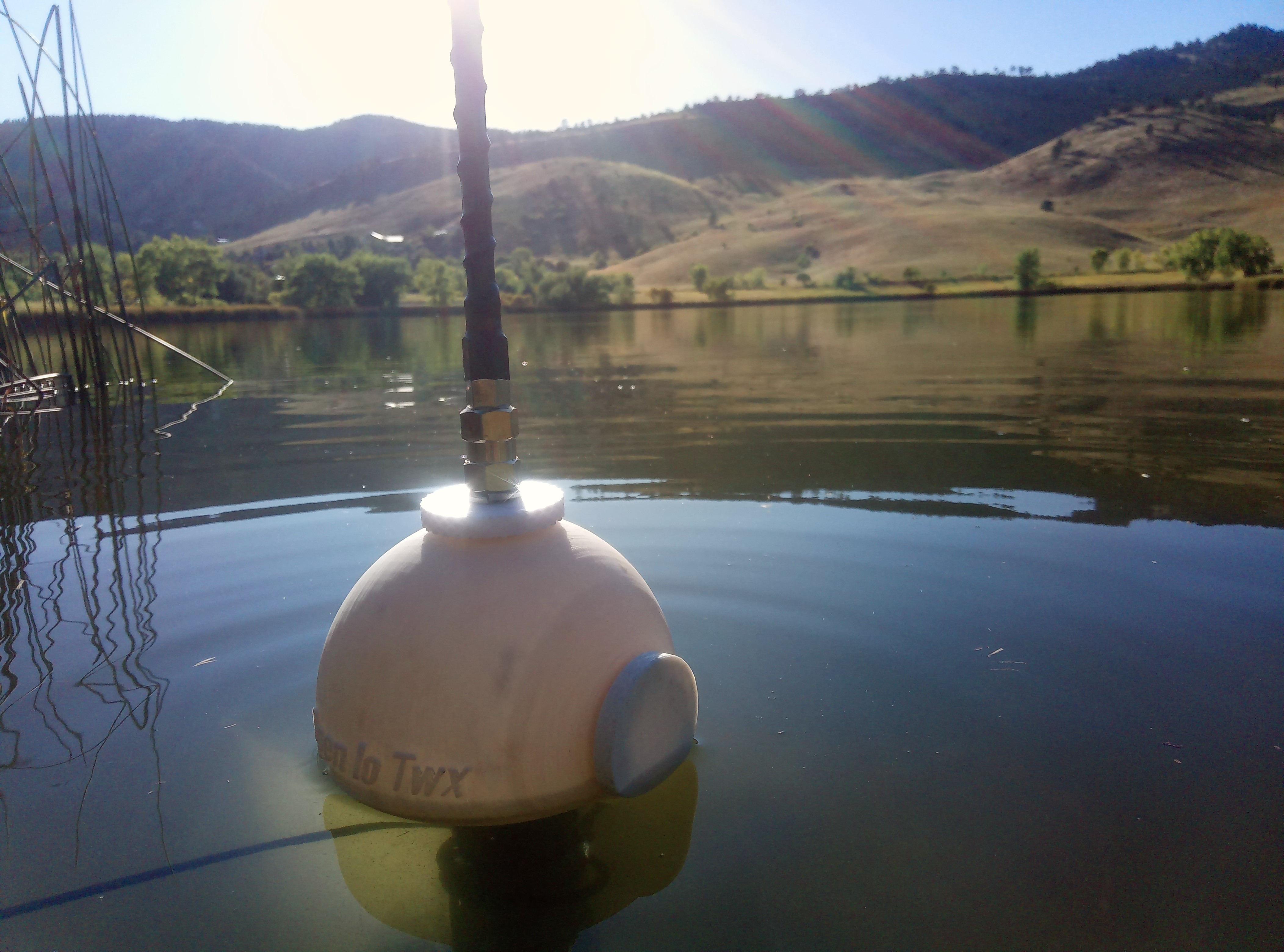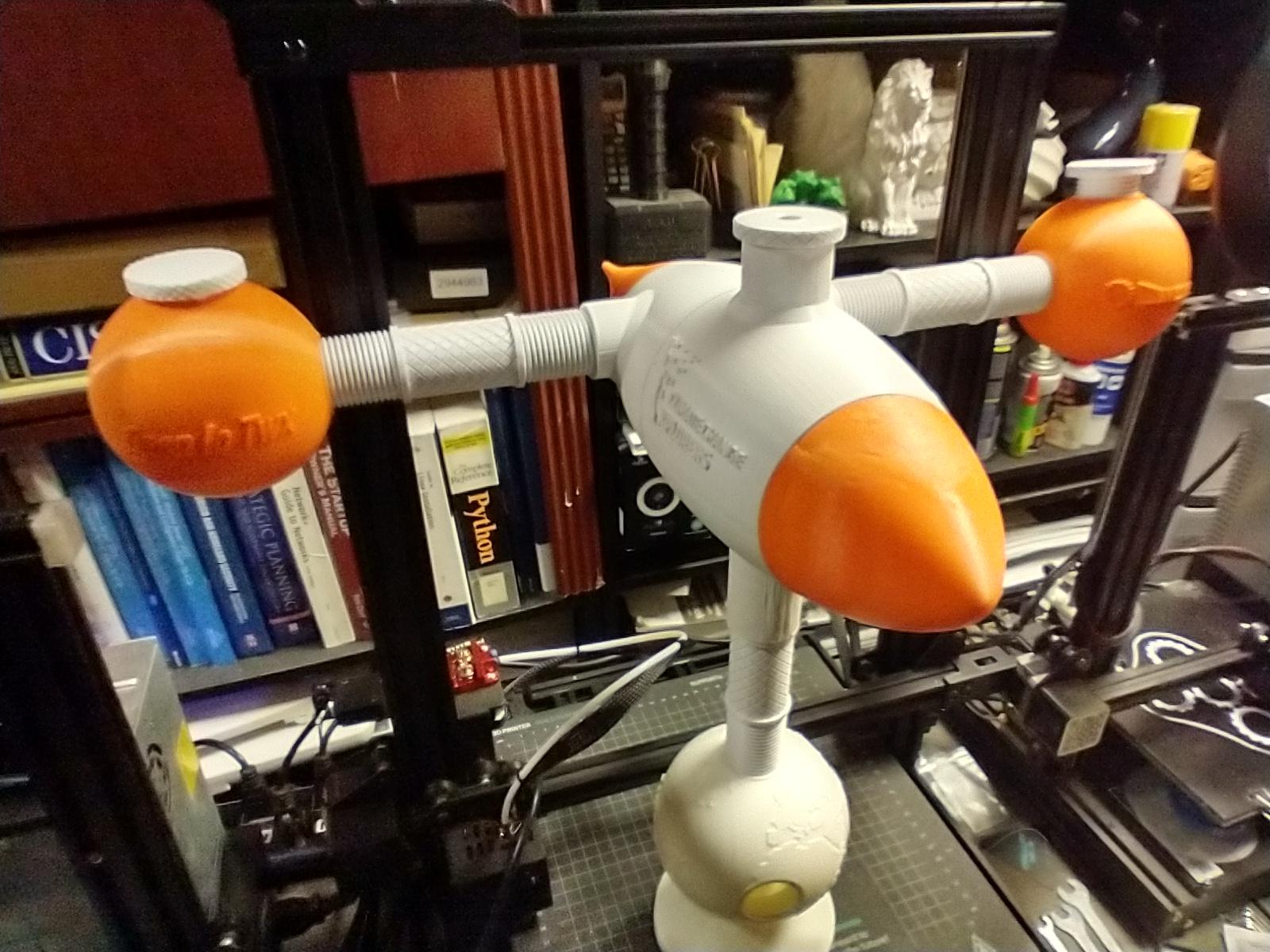

We are excited to introduce a very early concept of an open iot floater for sensing in lakes, reservoirs, sea ice, and open ocean environments. In the spirit of openess and community driven open source design ethos we are happy to introduce this early prototype concept during this ideation stage for community input and co-design. We welcome your thoughts and contributions to this project. This project is under open source GPL-3 license and builds on the flexible openiotwx land based platform launched 2017.
This is not a new concept as the global network of bouys serve as a critical element of the earth observing network. For example, The GOOS Buoys are an important part of the Global Ocean Observing System (GOOS), which is a global network of ocean observing platforms. The GOOS Buoys collect data on a variety of oceanographic parameters, such as water temperature, salinity, turbidity, and currents. Other parameters in lakes and reservoirs could include water PH, dissolved oxygen, conductivity, and oxidation.
Ocean science typically requires massive research vessels and/or large governmental budgets generally out of reach of developing nations and marginalized communities. For example, A typical GOOS Buoy can cost anywhere from $100,000 to $500,000. The cost of the buoy includes the hardware, software, and installation. The cost of maintenance and operation is also significant, and can add up to $100,000 per year. Buoys can take many forms from anchored bouys to floaters which are carried by currents. The standards for buoys can be found here.
The cost of an ocean science research vessel can vary greatly depending on the size, capabilities, and equipment of the vessel. A small, basic research vessel can cost around $10 million, while a large, state-of-the-art vessel can cost hundreds of millions of dollars. For example, the CHRV, a 125-foot research vessel owned by the University of New Hampshire, cost $11.5 million to build. The R/V Knorr, a 238-foot research vessel owned by the Woods Hole Oceanographic Institution, cost $100 million to build. Using the rule-of-thumb that says annual operating budgets of around 10%-20% the costs of the vessel it is clear these efforts require significant financial resources. While this approach is important for the advancement of ocean science, open iot believes we should empower local communities and citizen scientist to play a role in building their own open source observation networks with low cost sensors, 3D printers, open science princaples (FAIR/CARE/FPIC) and community contributors.
NOAA manages the National Data BouyCenter which shows a large number of buoys deployed accross the world by various organizations. Open IoT is an opportunity to democratize data collection in water.
QPR Labs featured low cost Do-it-Yourself floaters or circumnavigators that used ham radio frequencies WSPRnet to send measurements as seen here. This is an outstanding example that used PVC pipe weighted at the bottom and a fishing pole as part of the antenna. These DIY circumnavigators has demonstrated the viability of such a concept. This project builds on the open iot wx platform started in 2017 for land based systems to allow for coastal and maritime communities to use IoT and open science to build community lead climate change resiliency and adaptation programs.
In alignment with the open iot mission, our goal for the open iot floater is as follows:
Fill data deserts over water bodies, waterways, and open ocean via durable low cost open iot floaters and bouys to build community led climate resilience and adaption programs.
Empower a diverse cohort of citizen scientists from fisherman and maritime professionals to yacht cruisers to collect data from water bodies affecting their coastal or maritime communities.
Examine how citizen science ocean floater networks can improve open source community earth systems models such as WRF, MPAS, CSEM, and MOM6.
The spherical balls or “orbs” currently used to house the microcontrollers in the open iotwx design can float so it is the basis of our open iot floater design. We foresee two potential configurations: an single sphere with keel and antenna and a catamaran open IoT floater with five “orbs” or spherical balls for enhanced stability and capacity to attach more sensing nodes. Both options uses a 48 inch amtenna for the masts with a keel bulb for stabolity and righting. Pip Hare demonstrates this concept of righting with an idealized demo of a “90 degree” test to insure the craft will correct upright.


The floaters can be allowed to float freely, can be anchored if in a lake/reservior, or use a drogue or even a sensor chain when deployed in open ocean.
The parts list includes:
| Area | Component | Price Per Unit | Number of Units | Total Price | Source |
|---|---|---|---|---|---|
| Microcontroller | M5 atomlite | $7.50 | 1 | $7.50 | (M5) |
| Cables | qwiic to grove cable | $1.60 | 1 | $1.60 | (sparkfun) |
| Cables | qwiic adapter | $1.60 | 1 | $1.60 | (sparkfun) |
| Cables | usbC=>usbA adapter (2pk) | $7.99 | 1 | $7.99 | (amazon) |
| Cables | usbC=>usbA 10ft cable (5pk) | $13.59 | 1 | $13.59 | (amazon) |
| Sensors | Water Temperature | $18.95 | 1 | $18.95 | (seeedstudio) |
| Sensors | Water PH | $99.00 | 1 | $99.00 | (seeedstudio) |
| Sensors | Dissolved Oxygen | $44.95 | 1 | $44.95 | (adafruit) |
| Sensors | Tubidity | $24.10 | 1 | $24.10 | (adafruit) |
| Sensors | Wave height/water level | $4.95 | 1 | $4.95 | (mouser) |
| Sensors | Alternative - Fieldkit Water 4 sensor pack | $690.95 | 1 | $765 | (fieldkit.org) |
| Power | voltaic v75 (20mah) | $79.00 | 1 | $79.00 | (voltaic) |
| Power | Voltaic Solar Panel | $15.93 | 1 | $15.93 | [(voltaic)]( |
| Communications | Sparkfun SWARM Satellite | $199.99 | 1 | $36.99 | (Amazon) |
| Communications | Redpocket 1 yr SIM (TMOBILE ONLY) | $30.00 | 1 | $30.00 | (ebay) |
| Communications | Antenna (Amazon) | $15.99 | 1 | $30.00 | (Amazon) |
| Communications | Antenna Mount | $11.99 | 1 | $30.00 | (Amazon) |
For access to the 3D printed files and code base go to our codeberg (similar to github) repository below:
Conductivity (Salinity)
PH or alkalinity Levels
Dissolved Oxygen
Water Temperature or Sea Surface Temperatures
Turbidity
Wave height or water level
Barametric pressure and position/drift (i.e. polar ice tracking, current/spill tracking)
Senor selection and calibration: A wide range of low cost sensors are available for communities to understand water systems around them. We invite you to join us in testing sensors for your community use case. Core challenge is sensor performance while constantly submerged in fresh or salt water.
Waterproofing and durability: preventing leaks by waterproofing the open iot floaters for the harsh enviornments of the open ocean, lakes, reserviors, and other water bodies is a difficult challenge. The keel bulb will hold batteries and other electronics while the orbs will house microcontrollers. Durability in polar regions is also a challenge.
Communications: When out of cellular range communications must rely on either satellite transmission, LoRA, or ham radio frequencies called WSPRnet. This implentation is in progress and will be posted to the codeberg repository. Additionally, we are currently working an implementation with sparkfun swarm satellite sensor that does not require obtaining a ham radio license.
Power: The voltaic V75 provides 19,200MaH. Work in progress includes a solar panel option that can connet or, even better, be molded onto the top of the orb part of the floater.
Recovery, loss, and environmental impact: Reducing the amount of waste and environmental impact is critical. First, we must reduce the amount of non-biodegradable plastics used in the systems. This includes, use of biodegradable 3D print material and biodegradable PVC piping. Second, improve recoverability of floaters. This is more straight foward with anchored or moored systems in lakes and reserviors, but alot more challenging in open ocean even with a non emergency recovery beacon.